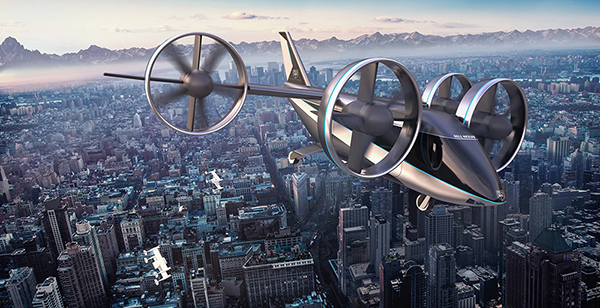Bell leverages Vicon’s motion capture cameras to emulate GPS while testing delivery drones in its indoor lab.

By Tim Massey, product manager, Vicon
Aerospace manufacturers have spent nearly a century perfecting their trade, producing the fastest and safest manned aircrafts for civilian and military air travel and delivery. But in 2018, industry leader Bell disrupted the field when it injected innovative technology into the heart of its offering by switching to a mobility-as-a-service business model.
The new strategy, led by the Bell Innovation arm, focuses on “targeting autonomous mobility – moving people, packages and data,” according to Grant Bristow, technical lead for its Intelligent Systems team. At the center of the strategy are the Bell APT delivery drone and the Bell Nexus 4EX, a hybrid-electric or all- electric powered air taxi that uses four tilting, ducted fans to fly. But the Bell Innovation team knew that to provide true mobility-as-a-service, it would need to go beyond selling an individual vehicle – it needed to deploy connected fleets to cover entire cities.
The challenge? Developing a digital backbone to seamlessly connect these fleets.
The first step toward developing a connected fleet was testing a fleet of proxy APT and Nexus vehicles indoors. But this came with constraints, as vehicles cannot leverage GPS data within a lab like they can outdoors. To solve for this limitation, Bell turned to another innovative technology for support – motion capture cameras.
Partnering with motion capture provider Vicon, Bell leveraged 16 motion capture cameras around its indoor lab to capture location data outputs from the autonomous drones. Once the camera systems were calibrated and the team set an origin within the Vicon system, they could tie that origin to a longitude and latitude point on the Earth. As the cameras captured the positions of several drones in real time, the system could effectively emulate GPS indoors and simulate a network of vehicles. The Bell team then used this proxy network of Nexus and APT vehicles as it developed the software that would eventually control the network out in the wild, called AerOS.
Motion capture systems have been used to advance drone use cases for several years. For example, the InnovationLab at Germany’s TU Dortmund uses Vicon’s optical motion capture systems to improve human and machine interaction in warehouses. Using a combination of cameras and motion capture suits, swarms of drones can be monitored and verified as they fly autonomously throughout warehouses avoiding contact with and keeping a safe distance from workers, demonstrating that drones will not need a fixed infrastructure to navigate indoor warehouse environments in the future.
Additionally, the cameras are used to help train the research team’s algorithm by capturing, labeling and learning manual warehouse tasks. The data outputs help the team identify and improve the ergonomics of these activities, ultimately increasing warehouse and production efficiency.
To solidify its entrance into the tech sector, Bell’s Intelligent Systems’ team needed to showcase the technical capabilities of this futuristic, connected fleet for the industry and their peers. So, they took the fleet to CES, the largest technology show in the world, to build “Nexus City.” The scaled down, smart city installation featured not only replica city buildings and skyscrapers, but an entire fleet of Nexus 4EXs continuously flying around the city display, nonstop, all day long. To develop the fleet, which would include 12 drones flying simultaneously across two city models, they needed to make the original proxy fleet bigger, so they called on Vicon once again for support.
After mapping out the space and the obstacles the fleets would encounter, Vicon’s engineers helped Bell install 32 Vicon cameras across two city setups, one on each side of their booth and each with its own fleet network. Now working with two virtual networks, the Intelligent Systems team worked with Vicon engineers to funnel the data through one switch – a new approach for both companies.
Their next challenge was keeping multiple flying vehicles in close proximity above a small booth space without any collisions. The team needed to capture the vehicle’s precise in-flight data outputs to be successful. With specific orientation, configuration and on-site calibration from Vicon engineers, Bell could trust that the feedback the vehicles received was accurate and that collisions would not occur during the show.
Following the success of Nexus City at CES, Bell’s Intelligent Systems team returned to the lab to continue developing and advancing AerOS, still using motion capture cameras as they continue to innovate. “So we’re continuing to improve and invest in this lab,” said Bristow. “Now it’s become the status quo. Flying the drone is not the cool thing. But it allows us to test and improve AerOS and go from idea to deployment and testing very quickly.”
About the Author
Tim Massey is a product manager at Vicon, an award-winning, leading provider of tailored motion capture systems for the life sciences, media and entertainment, location-based virtual reality and engineering industries. Tim has worked in manufacturing, supply chain and technology for 10 years, and holds an MBA from Harvard University and a Master’s degree in engineering from The University of Durham.
Formally at Microsoft working on various operational technology projects, Tim joined Vicon as the product manager for Engineering & VR at the beginning of 2019.
Scott Ellyson, CEO of East West Manufacturing, brings decades of global manufacturing and supply chain leadership to the conversation. In this episode, he shares practical insights on scaling operations, navigating complexity, and building resilient manufacturing networks in an increasingly connected world.